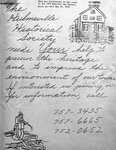



Following incorporation in 1872, Hulmeville continued to flourish. The mills were running and there were a couple of textile factories running in town. Johnson Hall became a popular meeting place for social groups and all sorts of entertainment events, ranging from concerts to debates that took place on the upper floors. The first floor was a store and, based on newspaper accounts, it was where townspeople got together to catch up on the day’s events.
Many of the homes on Main Street today housed some sort of business enterprise in the late 19th century. There was a millinery shop, a boot shop, a couple of general stores, blacksmith, wheelwright, tinsmith, restaurants, a bakery and more.
The late 19th century brought technological advancements that were readily adopted in Hulmeville. First gas lighting, then the telephone and electricity came to town. Borough Council worked to keep Bellevue Avenue in good shape so that residents had easy access to the new railroad that stopped at Langhorne Station.
In the 1890s, the trolley days began. A trolley line was built through Bucks County that linked towns between Doylestown and Bristol. Hulmeville was a stop on the line, and this helped to bring even more people into the borough.
Charles Haefner took advantage of this in 1899 by creating Dewey Park along the Neshaminy Creek near the dam. People used the train and trolley to come from all over Bucks County and even Philadelphia to relax, canoe, fish, swim and picnic along the creek. The park hosted concerts and had a carousel and other amusements.
After a couple years it was renamed Hulmeville Park. A dance hall was built, and the early sounds of jazz were echoing over the creek. Another very popular pastime in Hulmeville during that era was baseball. Hulmeville hosted baseball teams since the 1870s, and by the 1930s the games had become extremely popular. In 1933, more than 2,000 people attended a championship game at Reetz Field.
Hulmeville residents did their part during World War I and World War II by joining the military and supporting the war effort on the home front. The community began a tradition of honoring these efforts by holding annual Memorial Day parades and constructing war memorials. The WWI memorial included a mounted Hotchkiss gun on the bridge over the Neshaminy. A second memorial was erected at Memorial Park near the intersection of Bellevue Avenue and Neshaminy Street.
The most dramatic change that came to Hulmeville since incorporation took place outside the borough. Levittown and other suburban communities began being built in the 1950s. The surge in population along with new, roads, shopping centers and employment opportunities significantly diminished Hulmeville’s role as a commercial hub in Lower Bucks County. The mills operated for a couple more decades, but the storefronts gradually closed. The Hulmeville Post Office was shuttered in 1956, although a postal contract station continued to serve the town. The Hulmeville School held its last classes in 1965. The town’s identity was changing.
Rejuvenation came in 1972 when Hulmeville residents decided to celebrate the 100th anniversary of incorporation. They formed a Centennial Committee, wrote a history of the town and hosted many community events. The Centennial Celebration was a huge success.
After it was over, some of the organizers decided to create the Hulmeville Historic Society to keep the community spirit alive.
The Hulmeville Historical Society was formed 50 years ago this month. Members dedicated themselves to environmental improvement and preserving the town’s heritage. They quickly realized that development in Bucks County could threaten historic Hulmeville. The bridge over the Neshaminy needed to be replaced and some were talking about making Trenton Road a four-lane highway through the center of town.
To protect the historic buildings, the society worked to get part of the borough recognized as a historic district. It took years, but the historic district was placed on the National Registry of Historic Places in July 1986.
Ironically, just as the historic district initiative was wrapping up, a developer announced plans to demolish Johnson Hall — it had fallen into disrepair — and build a convenience store in its place.
Members of the historic society mobilized residents to save the hall, arguing that it sat at the heart of the newly established historic district. The fight went on for a couple of years but, in the end, Johnson Hall was saved.
The historic society has worked tirelessly since its creation to document the town’s history and maintain community spirit. One of the original members — June Robinson — will turn 99 this year. She still serves as its corresponding secretary.
In 1980, the historic society organized the first Old Town Flea Market. The now-annual event attracts thousands to Hulmeville every September.
The Hulmeville Historical Society still works to keep the community spirit alive with Easter egg hunts, soup-off contests, senior citizen lunches, historic house tours, community picnics and holiday events. It also contributes volunteer hours and money to countless community projects.
Note: A complete history of Hulmeville is available from the Hulmeville Historical Society. Contact: jcole1052019@gmail.com.
Joe Coleman is the Hulmeville Historical Society’s archivist and a member of its board of directors.
“Heralding Our History” is a weekly feature. Each month, the Herald delves into the history of one of its towns.
Join our readers whose generous donations are making it possible for you to read our news coverage. Help keep local journalism alive and our community strong. Donate today.